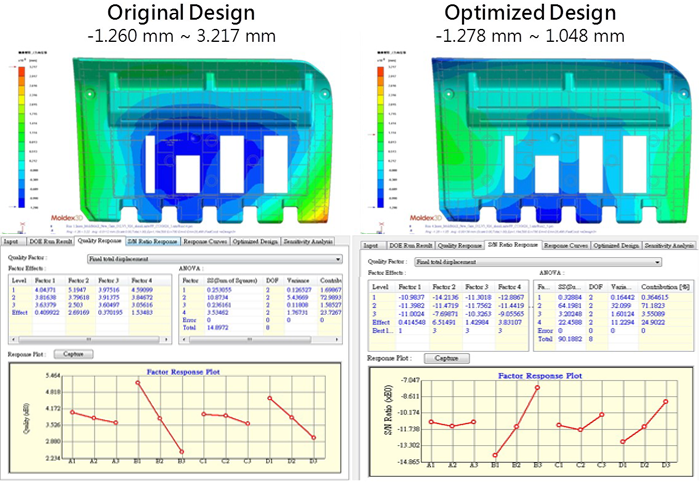
Optimization of plastic injection molding by the Design of Experiment (DOE) method
ESPECIALLY FOR OUR USERS
For years, consumers' high demands on products have led to a constant improvement of components, tools and manufacturing processes. It is well known that this can lead to a high expenditure of time and money, especially if it takes place in the later steps of the development process. Moldex3D offers a Design of Experiment (DOE) capability that assists you along each stage of the development phase ...
The usual procedure to opimize the injection molding process first involves examining the processes on the injection molding machine. The purpose of the test is to determine the stability of the process and to define possible improvements to mold and process parameters in order to achieve the desired requirements (e.g. optimization of molded part warpage, reduction of surface defects, ...). With the help of the knowledge gained, a number of trials are carried out on the mold and machine in order to take into account further experience for the next adjustments with each new trial. If the individual tests reveal problems or defects, these are attempted to be solved by adjusting the machine parameters and/or the tool in order to iteratively achieve the desired result. Finding a solution often requires the help of experienced personnel to keep the effort low. If there is a lack of experience, the problem can become more serious, causing costs to skyrocket.
There is another way. In addition to high product requirements, time-to-market and a shorter product development cycle are the drivers for using scientific and analytical methods from rapid design.
These can avoid unnecessary trial-and-error approaches and usually lead to a reduction in development costs.
By using statistical design of experiments, time and costs can be reduced during optimization.
DOE involves the use of mathematical-statistical methods under certain cost and time constraints to perform experiments. This method helps to find an optimum for the different criteria from a number of simulative trials. In doing so, users should obtain a maximum of information from the experimental data. The Moldex3D DOE module has been designed with the aim to improve the efficiency of information access and transfer. Different experimental approaches (design of experiments, trial & error, single factorial experiments, full factorial experiments and Taguchi's orthogonal fields) are available. In particular, the use of multiple quality and weighting factors for DOE analysis allows you to focus on different requirements.
You, as a user, will be able to provide insights to your development colleagues through the use of the Design of Experiment module, which will help identify an optimal tool design as well as ideal process parameters.
The Moldex3D DOE module provides another professional tool, with which the user achieves optimal analysis results by only performing a few settings and receives an automatic graphical summary. This supports the user to optimize the design with regard to the process. This method is used to increase productivity, help users find optimal parameters and control product quality more precisely.
To learn more about the new features and applications, the SimpaTec team is more than happy to answer your questions.
